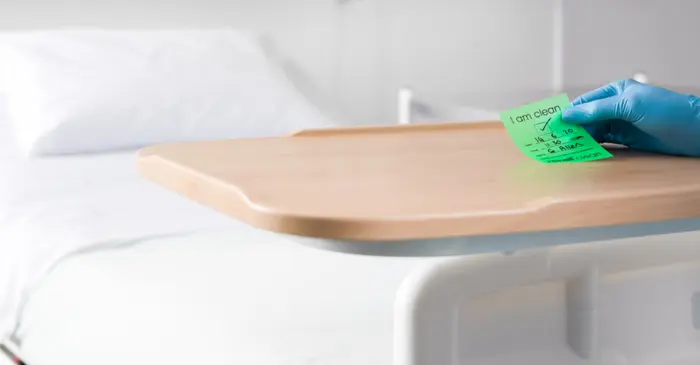Posted
19th March 2021
Research
PHE have recently published a multi-centre study of SARS-CoV-2 contamination of surfaces and air in England.
Where was the study undertaken?
The study was undertaken in 8 hospitals in England during the first wave of the COVID-19 pandemic.

Sampling:
Sampling of surfaces and air was undertaken around patients who were known to be infected with SARS-CoV-2, including single rooms and bays. Some shared clinical areas (e.g. nursing stations) and wards where no known patients infected with SARS-CoV-2 were present were also sampled. The sampling of surfaces and air for SARS-CoV-2 was undertaken by PCR and viral culture. Bacterial sampling of surfaces was undertaken in parallel.
What were the results of the study?
SARS-CoV-2 RNA was detected on 30 (8.9%) of the 336 surfaces sampled and from 4 (7.3%) of 55 air samples. No viable virus was cultured from the samples, most of which was detected a low level by PCR.
However, it is not clear whether the methods currently available to culture SARS-CoV-2 mean that live virus is present but not able to be cultured in the lab.
The mean aerobic colony count from the surface cultures was 1 cfu per cm2. This is a very low level of contamination – and lower than you would expect to see in an acute healthcare environment. In fact, this is considerably lower than the proposed standard for cleanliness in healthcare settings of < 2.5 cfu per cm2.
So, this suggests that the enhanced cleaning and disinfection being done to manage the pandemic was taking effect.

Conclusion:
The findings from this study – in line with others – suggest that SARS-CoV-2 is detectable on surfaces and in air but not cultivable. This suggests a low level of contamination, which may present a risk for transmission and reinforces the need for the highest levels of environmental hygiene.
How many hospitals were using Clinell Universal products?
7 of the 8 hospitals were using Clinell Universal detergent and disinfectant wipes for routine cleaning and disinfection, with chlorine-based disinfectants for terminal disinfection.
Other studies have shown that switching to a Clinell Universal Wipe is a good way to reduce overall contamination levels and hence transmission risk in hospitals.
Additionally, studies show that switching to 2-in-1 wipes also saves time which brings operational benefits.
What role did Clinell Universal play?
Overall, 8.9% of 336 surfaces and 7% of 55 air samples were contaminated with SARS-CoV-2 RNA by PCR, but viable virus was not cultured from any of the surfaces. Because…
all but one of the hospitals were using Clinell Universal detergent and disinfectant wipes for routine combined cleaning and disinfection.
The levels of bacterial contamination identified during the study was low, suggesting that enhanced disinfection recommended by PHE was having an effect.
Clinell Universal Wipes are proven effective against the coronavirus that causes COVID-19 (SARS-CoV-2) in a 30 second contact time. For more information, take a look at our Clinell efficacy article.
SHARE THIS ARTICLE
Tags
Latest News
Celebrating 20 Years of GAMA Healthcare: Our Story
This month, GAMA Healthcare celebrates 20 years of helping prevent…
Norovirus: Understanding its transmission and prevention in the UK
Introduction Norovirus is recognised as the leading cause of viral gastroenteritis…
Clean Between to Reduce Healthcare-Associated Infections
Healthcare-associated infections (HAIs) are a significant concern for healthcare facilities…
Mpox: emergence of a new threat
A new threat related to mpox is emerging, in the…




